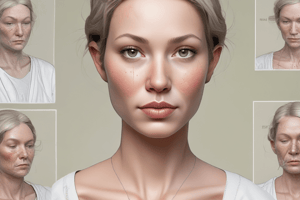Podcast
Questions and Answers
What is the most common complication associated with surgical incisions?
What is the most common complication associated with surgical incisions?
- Surgical site infection (SSI) (correct)
- Seroma formation
- Surgical wound dehiscence
- Haematoma formation
Which type of surgical incision is generally associated with lower infection rates compared to vertical incisions?
Which type of surgical incision is generally associated with lower infection rates compared to vertical incisions?
- Longitudinal incisions
- Transverse incisions
- Diagonal incisions
- Horizontal incisions (e.g., 'Smith's incision') (correct)
Which of the following is NOT a potential complication of surgical incisions?
Which of the following is NOT a potential complication of surgical incisions?
- Surgical wound dehiscence
- Seroma formation
- Improved incision healing (correct)
- Haematoma formation
What is a key risk factor for complications in obese patients undergoing surgery?
What is a key risk factor for complications in obese patients undergoing surgery?
What is the primary economic impact of incisional closure complications?
What is the primary economic impact of incisional closure complications?
Which of the following statements about vertical incisions is true?
Which of the following statements about vertical incisions is true?
Which of the following factors can impact the healing process after surgery?
Which of the following factors can impact the healing process after surgery?
What is the purpose of Incisional Negative Pressure Wound Therapy (INPWT)?
What is the purpose of Incisional Negative Pressure Wound Therapy (INPWT)?
Which of the following is NOT mentioned as a potential benefit of INPWT?
Which of the following is NOT mentioned as a potential benefit of INPWT?
Which of the following is involved in the healing process after surgery?
Which of the following is involved in the healing process after surgery?
What is the purpose of negative pressure dressing technology?
What is the purpose of negative pressure dressing technology?
Which of the following statements is true?
Which of the following statements is true?
Flashcards are hidden until you start studying
Study Notes
Complications of Surgical Incisions
Surgical incisions play a crucial role in the success of many operations. However, they can also pose risks and complications if not properly managed. One of the most common complications is postoperative surgical site infection (SSI), which accounts for approximately 17-22% of healthcare-associated infections. Other complications include surgical wound dehiscence and formation of haematomas or seromas, which can lead to delayed or impaired incision healing. These complications are more likely when wounds are closed under tension or in patients with specific morbidities, such as obesity. Obese patients may also face difficulty obtaining adequate exposure to the surgical field due to increased subcutaneous fat, predisposing them to greater tissue oedema and seroma formation. Incisional closure complications can have significant economic implications for healthcare systems due to increased medical and surgical procedures required.
Types of Surgical Incisions
Several types of surgical incisions exist, each with their own considerations regarding healing and potential complications. For example:
- Vertical incisions: These incisions are commonly used in abdominal surgeries and can be associated with higher risks of infection compared to horizontal incisions.
- Horizontal incisions (e.g., 'Smith's incision'): Horizontal incisions are often used in laparoscopic procedures and generally have lower infection rates than vertical incisions. However, they may not provide sufficient access for certain procedures.
Healing Process After Surgery
The process of healing after surgery involves a series of biological and molecular events, including cell migration, proliferation, and extracellular matrix storing and remodelling. However, factors such as patient comorbidities like diabetes, hypertension, and vascular disorders, excessive suture tensions, surgical site contamination, surgical technique, operative time, estimated blood loss, and patient-related risk factors can all impact the healing milieu and potentially delay or impair healing.
In recent years, advances in negative pressure dressing technology have shown promising results in promoting healing in open wounds. Similarly, the use of Incisional Negative Pressure Wound Therapy (INPWT) has been investigated as a preventive measure to reduce complications in high-risk, clean, closed surgical incisions. While more studies are needed to fully understand its effectiveness, INPWT has shown potential benefits in reducing infection rates and sero-haematoma formation.
Studying That Suits You
Use AI to generate personalized quizzes and flashcards to suit your learning preferences.




